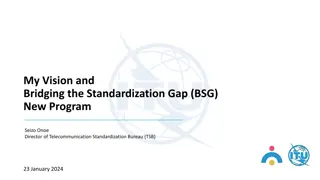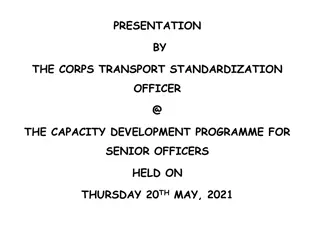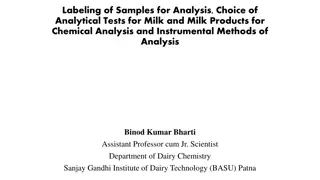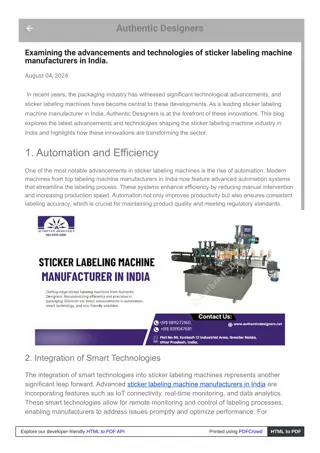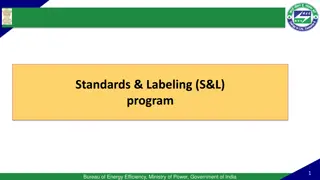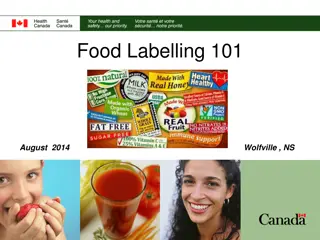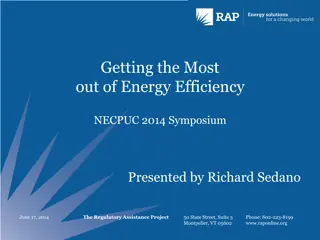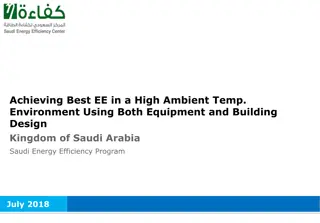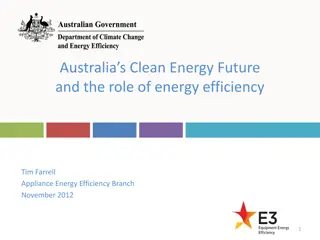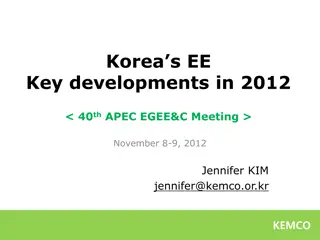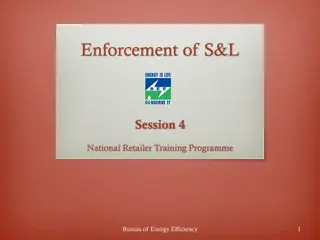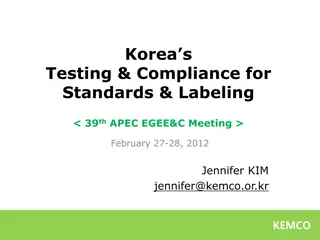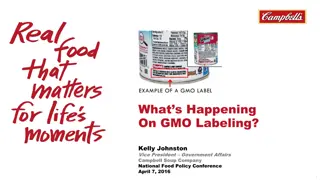Energy Efficiency Standardization and Labeling Requirements in Indonesia
Indonesia's energy conservation efforts are outlined through government regulations requiring testing and compliance for energy efficiency standards and labeling. The regulations cover responsibilities of government and private sectors, as well as guidelines for energy performance standards and labels on various appliances. The country aims to target specific products for labeling and has established a plan for energy efficiency implementation from 2011 to 2015. Coordination among ministries is crucial for effective product standardization policy and regulation authority.
Download Presentation

Please find below an Image/Link to download the presentation.
The content on the website is provided AS IS for your information and personal use only. It may not be sold, licensed, or shared on other websites without obtaining consent from the author.If you encounter any issues during the download, it is possible that the publisher has removed the file from their server.
You are allowed to download the files provided on this website for personal or commercial use, subject to the condition that they are used lawfully. All files are the property of their respective owners.
The content on the website is provided AS IS for your information and personal use only. It may not be sold, licensed, or shared on other websites without obtaining consent from the author.
E N D
Presentation Transcript
TESTING AND COMPLIANCE FOR STANDARD AND LABELLING Indonesia The 39th APEC EGEEC Meeting Sydney, Australia, 27-28 March 2012
GOVERMENT REGULATION NO. 70/2009 ON ENERGY CONSERVATION Gov t Regulation No.70/2009 on ENERGY CONSERVATION CONTENT 1 2 4 5 3 RESPONSIBLE OF CENTRAL GOV T, LOCAL GOV T, PRIVATES, AND COMMUNITY FACILITATION, INCENTIVE & DISINCENTIVE IMPLEMENTATION ON ENERGY CONSERVATION STANDARD & LABEL GUIDANCE AND SUPERVISION energy performance standard for electric appliances , and energy efficiency label Energy efficiency label should be implemented by producer and importer of energy appliances
Potensial Electricity Saving from Household Appliances Electricity consumption by consumer category and by appliances 2005 (%) Social Public Business Industry Household Lighting Ballast Others Street Lighting Refrigerator Potential Electricity Saving 36% 3
Energy Efficiency Label : SNI 04-6958-2003 (Comparative Label) LOGO 4 4 stage rating system stage rating system EE level EE level Product model Product model Registration No. Registration No.
Target Products for Labeling Compact Fluorescent Lamp 1. Refrigerator 2. Room Air Conditioner 3. Television 4. Electronic Ballast 5. Electric Fans 6. Electric Iron 7. Rice Cooker 8. Motor 9. Washing machine 10.
S & L Plan in 2011 - 2015 Year 2013 2011 2012 2014 2015 CFL Refrigerator and Air Conditioner Electric Ballast, fan, and TV Rice cooker and Electric motor Elecric iron and Washing machine
Product Standardization Policy and Regulation Authority REGULATION AUTHORITY DISTRIBUTION STANDARDIZATION MINISTRY OF ENERGY AND MINERAL RESOURCES ENERGY EFFICIENCY PERFORMAN CE STANDARD MINISTRY OF TRADE MINISTRY OF INDUSTRY SAFETY STANDARD NEED INTENSIVE AND CLOSE COORDINATION AMONG THOSE MINISTRIES
LS Pro & Testing Laboratory Testing Lab LS Pro Acredited by KAN or appointed by Government Check & ensure all provided data are correct. Arrange Testing. Verify Testing Result. Issue Product Certification. Acredited by KAN or appointed by Government Perform Testing based on Testing Standard and criteria. Issue Testing Result & Opinion. Independent LS Pro : Labeling Certification Body
LS Pro & Testing Laboratory on ESL Program Proposed Processing Time (Depend on Product) 2 days Accredited Testing Laboratory Accredited LS-Pro Producer/Importer Application Contract No Perform Testing Had Product tested by Accredited Lab 14-30 days Yes No Revision/ Correction Testing Result 2 days Testing Result Verification Yes Issue Product certification Product Certificate 1 day
Availabel Testing Lab P3TKEBTKE B4T BPPT LIPI BPMB Baristan Government PT Sucofindo PT Panasonic PT Polytron PLN LitBang Private
Testing Capability of Laboratories Products Available Laboratories Number of Accredited Labs CFLs 8 5 Refrigerator 6 1 AC 3 1 TV 3 N/A Ballast Fan Rice cooker 10 1 3 N/A N/A Motor Pump N/A N/A KAN = National Acreditation Committe 11
MINISTERIAL DECREE NO. 6 YEAR 2011 ON ENERGY EFFICIENCY LABELING FOR CFL The manufacturer or importer must issue a written declaration of conformity before the EE Label put in that product. Declaration of conformity submitted to the Ministry of Energy and Mineral Resources cq DG NREEC. Violations of the provisions of the Declaration of conformity may be sanctioned according to regulations. CFL production in domestic that do not bear signs of energy- saving label is pulled from the market. CFL imports that do not bear the label of energy saving signs are prohibited entry into Indonesia and must be re-exported or destroyed.
Energy Efficiency Rating for CFL MEMR Regulation No. 06/2011 on Energy Efficiency labeling (star rating) for CFL Presently 4 Manufacturers already informed their willingness to put EE label in their products in 2012. The Government plan to release the EE Labeling CFL in the Market by April 2012 .
Barriers on Implementing of Labeling Program Policy and Regulation Aspects Government Regulation No. 70/2009 mandates the producer/importer to implement energy efficiency labeling for home appliances, however there is lack of guideline to implement this regulation Bureaucracy is too convoluted, too many regulation body are included in systems Technical Aspects Lack of accredited testing laboratories and labeling certification body Not all appliances already had performance standard Most of the appliances do not have energy efficiency rating Lack of human resource capacity on testing laboratories Lack of support from Industrial assosiation Economic and Social Aspects High efficient products are costly, and domestic market is low price oriented Lack of knowledge and awardness on energy saving
The Question : What are the major compliance issues faced by your economy What would help your economy to improve compliance rate What testing capacities exist within your economy





